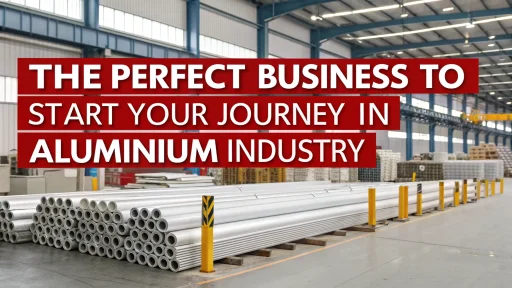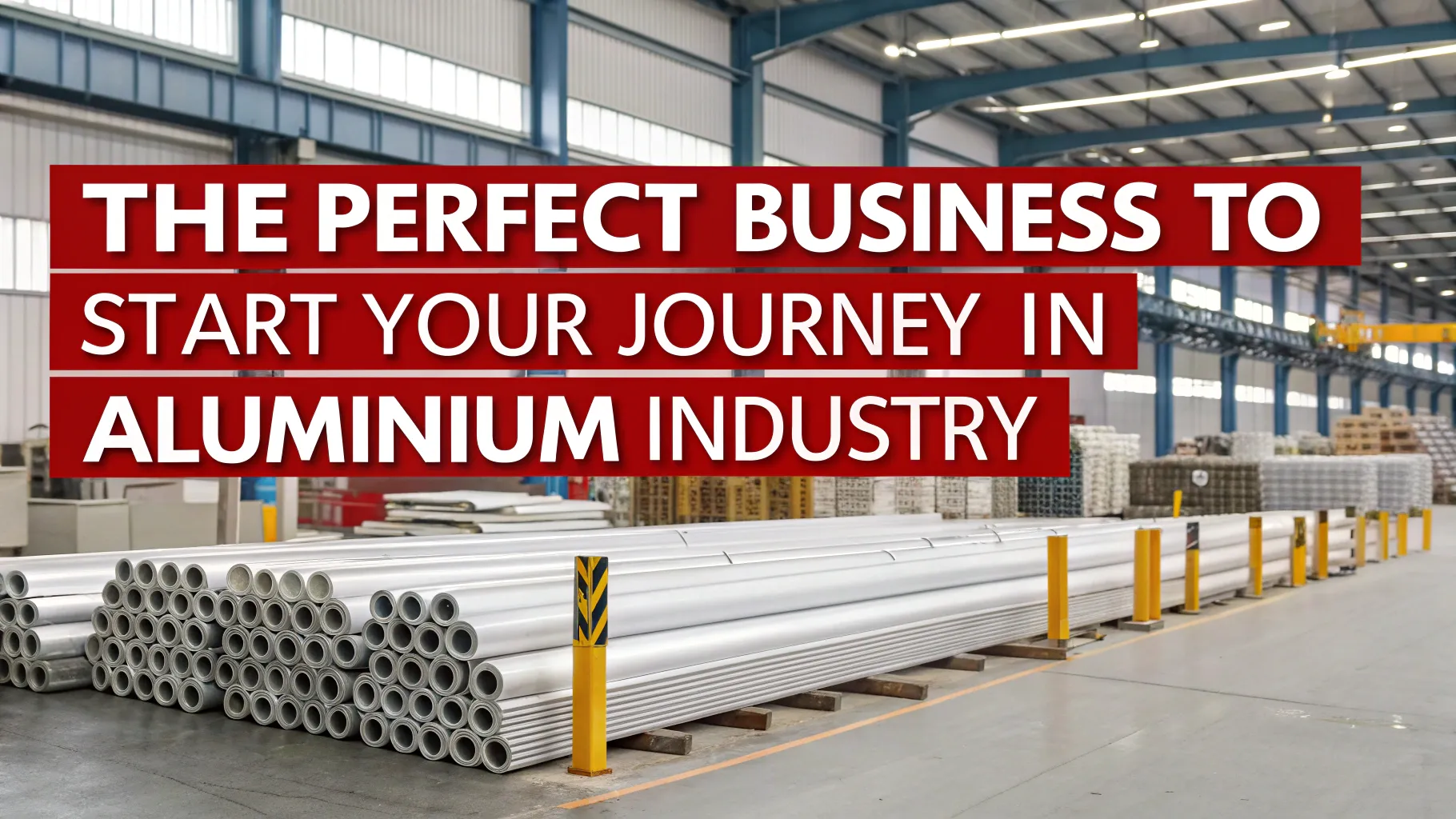The applications of aluminum are ever-increasing and it is one of the most critical materials in modern fabrication technologies. Used in the manufacturing of airplanes, tools, electronic devices, automobiles, and even in the packaging industries, its lightweight, corrosion resistance and mechanical strength is notable. It is especially attractive to entrepreneurs due to its endless recycling.
The aluminum sector offers more than commodity sales; it is rapidly evolving to focus on sustainability, manufacturing innovation, modernization, and efficiency.
This article is aimed at assisting young entrepreneurs in conducting thorough market research and developing an in-depth business plan. It covers the market’s outlook, key factors of demand, manufacturing processes, and opportunities.
Market Outlook: Estimation of Growth in India and Abroad
The aluminum business is doing well on a global level. Forecasts suggest that by 2030, it could exceed $250 billion. This marks a compound annual growth rate (CAGR) of about 4 to 5 percent, which is favorable for mature industries. Rapid urbanization, rising infrastructure investment, and the growing need for lightweight materials in manufacturing and transportation are driving this growth.
India has even better growth prospects. India has the second-highest reserves of bauxite ore in the world, which, coupled with the country’s infrastructure for production, makes it a top global aluminum producer. Domestic consumption is now growing at a rate of 8 to 10 percent a year, which is higher than the global average.
Large-scale infrastructure projects, an expanding automobile industry, and the government’s ‘Make in India’ campaign, which fosters local manufacturing, are driving this growth.
Related: The Aluminium Industry in India: A Growing Export Powerhouse
Understanding the Factors that Drive Demand
The strength of the aluminum industry lies in the diversified demand base. Out of all the industries, the construction industry is still one of the biggest consumers of aluminum because it uses it for windows, doors, roofing, and façade systems due to its high strength-to-weight ratio and its ability to resist corrosion. Experts predict a substantial rise in the urban population over the next two decades, which will increase aluminum consumption in housing and infrastructure projects.
The other major demand driver is the Transportation industry. In automotive manufacturing, the trend of lightweighting is forcing automotive manufacturers to replace steel parts with aluminum parts. This is important for the electric vehicle (EV) market because it allows an increase in battery efficiency and range. Railways, marine vessels, and aerospace manufacturing also follow similar trends, using aluminum alloys extensively for their performance benefits.
The electronics and electrical sectors make a strong contribution to the demand as well. Electronics manufacturers use aluminum in housings, power cables, conductors, and transformer parts because of its excellent electrical properties. Packaging companies are adopting aluminum for tablets, food trays, and pharmaceutical foils as the decline of traditional timber, crafted wood, and wood composites continues, since it can be recycled without degradation.
The Manufacturing Process: From Bauxite to Products
Mining of bauxite ore, which has a high concentration of aluminum oxide (alumina), is the first step in aluminum production. The Bayer Process transforms bauxite by crushing it, mixing it with caustic soda, and then heating and pressurizing it. The process then separates, washes, and dries the alumina.
The smelting step most often converts alumina through the Hall-Héroult method. In this process, molten cryolite dissolves the alumina, and electrolysis yields molten aluminum. Manufacturers then cast the metal into ingots, billets, or slabs for downstream processing.
Downstream processing focuses on different techniques based on the specific product. Rolling mills apply higher pressure rollers to slabs to create sheets and foils, processing them through repeated passes. Foundries create complex shapes by pouring molten aluminum into molds, and alloy plants add other metals to provide the aluminum with specialized properties.
Manufacturers enhance surfaces with anodizing, paint, or powder coating to improve corrosion resistance and aesthetics. They maintain strict quality control throughout the process, as the aerospace and automotive industries demand rigorous compliance with material requirements.
Related: Future Opportunities in Downstream Industries in Aluminium
The Sustainability Advantage of Aluminum
What sets aluminum apart from other industrial materials is the fact it can be recycled infinitely with no drop in quality. This makes it the backbone of the circular economy. Recycling aluminum requires up to 95 percent less energy than primary production, which leads to a major reduction in greenhouse gas emissions.
For business owners, this factor of sustainability brings more than just an environmental boon. It puts them in a market differentiation bracket. Suppliers providing low-carbon materials are preferred by customers from every industry. Additionally, multiple governments are offering incentives and regulations for promoting recycling. This creates ideal market conditions for the aluminum recycling business to flourish.
Advancements Reshaping the Industry
The aluminum industry is not stagnant; in fact, it is undergoing rapid change due to technological innovation. New aviation and military-grade alloys are being produced due to advanced alloy development, which is creating stronger and lighter materials. Furthermore, the use of high-speed aluminum extrusion presses is making the production cycles shorter and the shapes produced more intricate.
Another fascinating area is the 3D printing of aluminum powders, also known as additive manufacturing. This technology is enabling the manufacturing of intricate and lightweight parts that are mais impossible to construct traditionally. In the area of recycling, the use of AI-powered automated sorting systems is improving the recovery of scrap metal, which enhances the yield and quality of aluminum alloys produced.
Related Feasibility Study Reports: Aluminium and Aluminium Downstream Projects
Challenges and Solutions
There are challenges in every field and aluminum manufacturing is no exception. Energy consumption is always a leading concern, especially in primary smelting. This is a problem that can be solved by using renewable energy sources because, in addition to reducing operating costs in the long run, it enhances the brand’s image in terms of sustainability.
When raw-material prices fluctuate widely, they reduce profitability. Diversify your suppliers and source locally to stabilize costs. Moreover, compliance with quality and safety regulations is critical for the aerospace and medical device industries. Creating testing facilities and getting relevant certifications increases early brand credibility in testing markets.
Why Now is the Ideal Moment to Disrupt the Aluminum Industry
There are some global trends that are aligning to create a perfect atmosphere for new entrants. Aluminium is getting decarbonized which is accelerating the adoption of aluminum in transport, energy, and packaging. Furthermore, growing economies are advancing infrastructure, overall productive efficiency is at an all-time high, along with a strong regulatory market for reusable and low-carbon aluminum. This opens direct opportunities for companies to invest and capitalize.
For entrepreneurs looking to establish a new business, venturing into the aluminum industry presents an opportunity to target an industry with promising growth, strong fundamentals, and the option to focus on high-value specialized niches. With the proper business strategies, expert knowledge, and a relentless focus on quality, there is an opportunity to create a future-ready business that is immensely profitable.
For more information, check out this video on Aluminium and Aluminium Downstream Projects
About Niir Project Consultancy Services (NPCS)
NPCS prepares Market Survey cum Detailed Techno-Economic Feasibility Reports for numerous industries. NPCS assists entrepreneurs strategizing for new ventures, analyzing the industry landscape, providing a detailed breakdown of the entire manufacturing process along with the raw materials needed, plant and operational layout, and financials, covering all essential details to enable informed decisions.
Find Best Idea for Yourself With our Startup Selector Tool
Conclusion
Aluminum is pivotal to many innovations spearheading the global economy. The industry is not only a traditional manufacturing sector, but a gateway into some of the fastest-growing and technologically advanced markets, from electric vehicles to renewable energy systems.
As a first-time entrepreneur, one will get a unique combination of consistent demand, cross-industry adaptability, and alignment with long-term sustainability objectives. When you manage to keep up with industry innovations, choose a focused product line, adopt streamlined manufacturing processes, and make use of efficient industry innovations, you will be able to build a business that will support a more sustainable, greener industrial future while generating strong financial returns.







